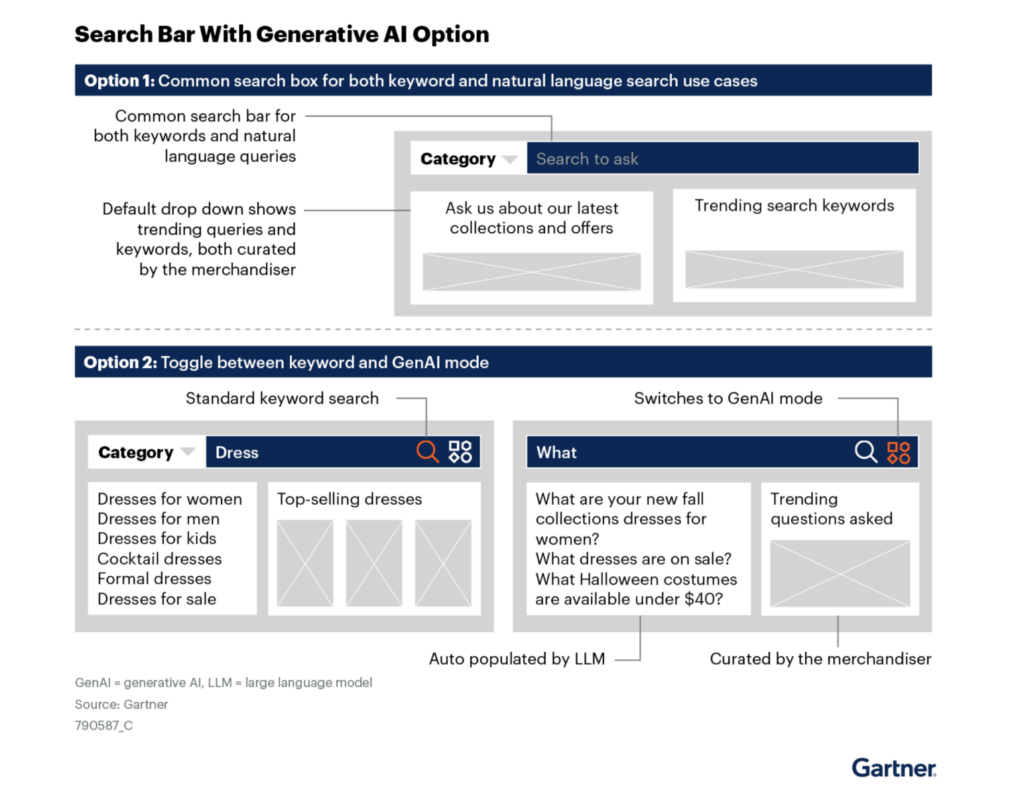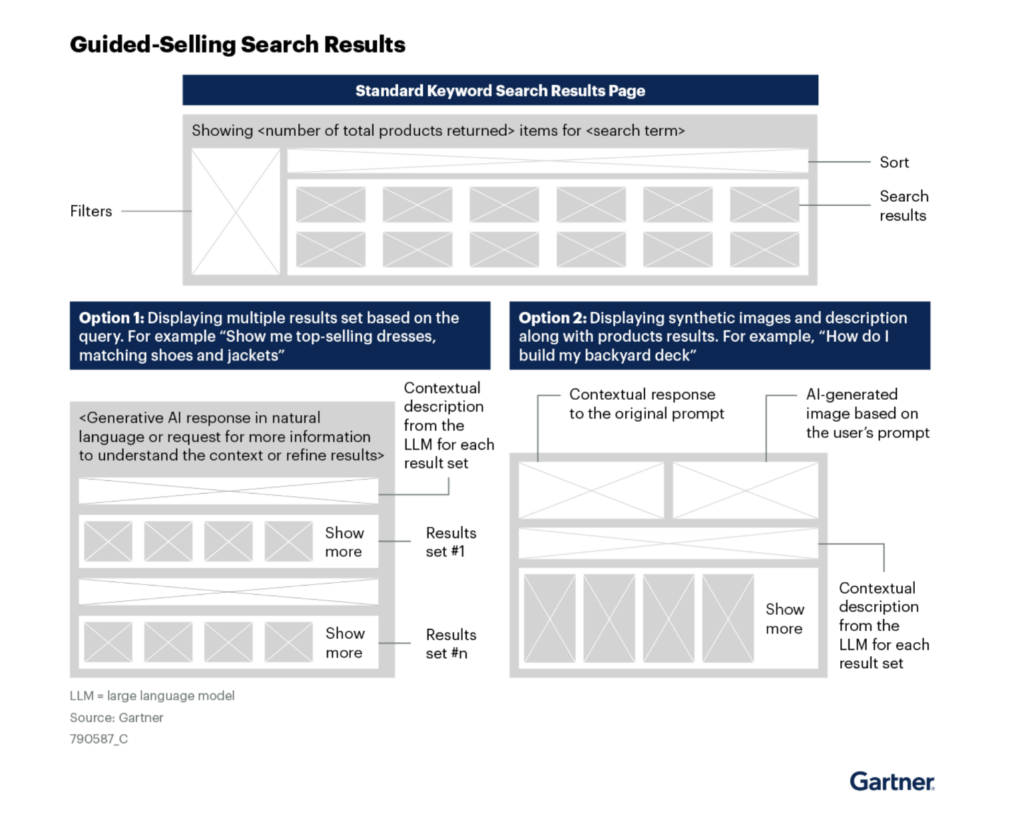You’ve heard the buzz around Generative AI (GenAI), but what is the most practical way to apply it to ecommerce search and product discovery?
If your organization is prioritizing the online buying experience in 2024, we believe the Gartner® Quick Answer report provides the clarity you’re looking for in order to feel confident in various AI technologies and implementation.
Below, we share key findings, including specific use cases and benefits of GenAI on your ecommerce search and discovery.
The Need for GenAI in Search and Product Discovery
Keyword search engines are some of the oldest engines in existence. They work by matching queries to indexed items — a.k.a. rank products by frequency of matched keywords — allowing shoppers to search and discover products in online catalogs.
The essential logic is that products are considered more relevant based on the number of times the keyword appears in the product name or description, and these engines often include the ability to set manual rules to break ties when they occur.
The advent of ChatGPT changed the game, setting the expectation for all search engines to understand and properly respond to natural language queries by default.
Starting with Enhanced Search
One of the most tested GenAI search and discovery use cases is the shopper “conversing” with the platform using an everyday question that includes more detail about their intent.
For example, imagine a customer asks a GenAI-powered search engine the following question: “What is the best-selling Lego set for a 7-year-old child who likes Star Wars?” Similar to physically asking a sales associate in a brick-and-mortar, the platform typically directs the customer to the appropriate products by combining a natural language response with more traditional search results.
In the following image, Gartner® offers suggestions on how online businesses might integrate keyword and natural language querying without disrupting the search experience while also promoting a new way to discover their catalog.

As illustrated in the image and as further broken down by Gartner®:
- Option 1: The shopper could either query a keyword or pose a natural language question. Based on the format of the query, the platform then delegates it to the most appropriate engine. The section in the autocomplete dropdown is the merchandised slot for displaying top-trending search keywords.
- Option 2: The shopper selects their search experience by toggling between the default keyword or using the new GenAI-based search. This way, merchandisers can measure GenAI adoption. In both scenarios, the autocomplete dropdown will display matching keywords and questions as the shopper is typing in their query.
Here at Constructor, when it comes to implementing emerging tech, we believe product adoption should take a user-centric approach. Encourage customers to try out new technology via an opt-in, allowing them to try new experiences when they’re ready and come back only when these experiences are genuinely helpful to them.
Made Even More Powerful with Personalization
Gartner® also shares that personalization is a critical capability for an enhanced search and discovery experience. It combines many elements to enable the platform to tune relevance and ranking during every interaction, such as:
- Customer data: Experience, clickstream, transactional, and historical data.
- Various analytics: Behavioral, next-best-action and predictive analytics.
- Artificial intelligence applications.
GenAI technologies like large language models (LLMs) take personalization “a step further by enabling the text of a product description to be personalized for a customer based on context — for example, interests and intent. The user’s queries and responses will also flow into the clickstream, which can influence site-wide experiences.”
GenAI That Mimics Real-World Understanding
Search and discovery platforms that use a combination of natural language processing (NLP) and LLMs to respond to customer queries with clarification questions — like budget, age of gift recipient, and use case — provide a more navigational interface. They’re able to better understand search context, just as a salesperson would do in-person.
According to Gartner®, “the standard search results will evolve to support natural language suggestions combined with synthetic imagery (that is, images generated partially or fully by AI) and search results.”
“Depending on the brand and services, the queries could be very specific, like seeking recommendations for special occasion outfits, specific parts for DIY projects, or replacement parts for B2B buyers.”

At Constructor, this guided selling experience comes in the shape of our AI Shopping Assistant (ASA), also named in the Gartner® Quick Answer Report.
When helping shoppers get started with ASA, there are some strategies ecommerce companies can consider:
- Item to item. Given an item as context, what other items might they be interested in? For alternatives, look for what you could substitute. For complementary, look for what you would add. This can solve for queries like “what are some good dips to go with some chips I just bought.”
- Shopper to item. Given what you know about a shopper based on their affinities (clickstream), what products might they be interested in purchasing next? This can solve for queries like “show me some outfits you think I may be interested in.”
- Intent to items. Intent-based recommendations aim to answer (most completely) which items, content, or other materials shoppers may need to meet their goal. Here you can recommend content, groups of items, expert advice, products, etc. This can solve for queries like “I want to make spaghetti carbonara tonight. What ingredients do I need?”
Overall, ASA shortens the time it takes for shoppers to go from goal to reality, allowing them to shop all in one place and effectively addressing a fundamental problem in the way people shop: taking hours to do something simple.
Recommendation to Adopt GenAI for Search and Discovery
The report states you should “choose search and discovery platforms that are already plugged into (or using their own) LLMs. Also, decide on platforms that can modify and administer prompts to meet your brand needs and comply with governance policies.”
Interested in learning more about implementing GenAI into your product search and discovery experience? Grab a complimentary copy of the report here.
Disclaimer: Gartner does not endorse any vendor, product, or service depicted in its research publications, and does not advise technology users to select only those vendors with the highest ratings or other designation. Gartner research publications consist of the opinions of Gartner’s research organization and should not be construed as statements of fact. Gartner disclaims all warranties, expressed or implied, with respect to this research, including any warranties of merchantability or fitness for a particular purpose.
Gartner, Quick Answer: How GenAI Impacts Digital Commerce Search & Discovery Experience, 30 November 2023, Aditya Vasudevan, Mike Lowndes
GARTNER is a registered trademark and service mark of Gartner, Inc. and/or its affiliates in the U.S. and internationally and is used herein with permission. All rights reserved.

